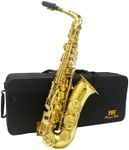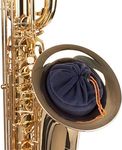Buying Guide for the Best Saxophones
Choosing the right saxophone can be an exciting journey, whether you’re a beginner, an advancing player, or a seasoned musician. The saxophone family includes several types, each with its own sound and feel. When shopping for a saxophone, it’s important to consider your musical goals, the style of music you want to play, and your physical comfort. Understanding the key specifications will help you find an instrument that matches your needs and supports your musical growth.Type (Soprano, Alto, Tenor, Baritone)The type of saxophone refers to its size and pitch range, with soprano being the smallest and highest-pitched, followed by alto, tenor, and baritone, which is the largest and lowest. This is important because each type has a distinct sound and is suited to different musical roles. Soprano saxophones are bright and piercing, altos are versatile and commonly used for beginners, tenors have a rich, deep tone popular in jazz and rock, and baritones provide a powerful, low sound often used in ensembles. To pick the right type, think about the music you want to play and your physical comfort—smaller saxophones are easier to handle for younger or smaller players, while larger ones may require more breath control and strength.
Material and FinishMost saxophones are made from brass, but the finish can vary, including lacquer, silver plating, or even gold plating. The material and finish can affect both the appearance and the sound of the instrument. Lacquered saxophones tend to have a warmer tone, while silver-plated ones might sound brighter. Some finishes are more durable and easier to maintain. When choosing, consider whether you prefer a certain look or if you want a specific sound quality, and also think about how much maintenance you’re willing to do.
Key Layout and ErgonomicsThe key layout refers to how the keys are positioned and how comfortable they are to reach and press. This is crucial for playability, especially if you have smaller or larger hands. Some saxophones are designed with adjustable keys or ergonomic features to make playing easier and more comfortable. When trying out saxophones, pay attention to how your hands feel on the instrument and whether you can reach all the keys without strain. Choose a saxophone that feels natural and comfortable for your hand size and playing style.
Intonation and TuningIntonation is about how well the saxophone stays in tune across its range. A well-made saxophone will have consistent tuning, making it easier to play with other musicians. Some saxophones are known for better intonation, especially in the higher or lower registers. When selecting a saxophone, listen for any notes that sound out of tune or require extra effort to correct. If possible, play or have someone play scales and check for tuning consistency. Choose an instrument that makes it easy to play in tune, especially if you plan to play in groups.
Included AccessoriesSaxophones often come with accessories like a mouthpiece, case, neck strap, and cleaning supplies. The quality and type of these accessories can vary. A good mouthpiece can make a big difference in sound and ease of playing, while a sturdy case protects your instrument. When comparing saxophones, check what’s included and consider whether you’ll need to upgrade any accessories. If you’re just starting out, having all the necessary accessories included can make getting started much easier.

















